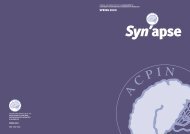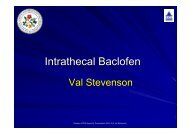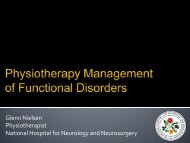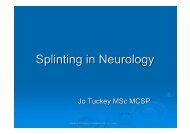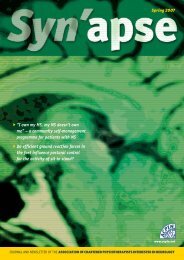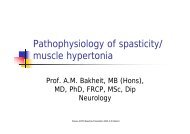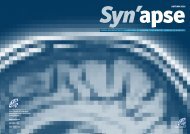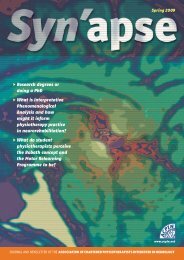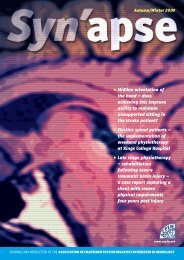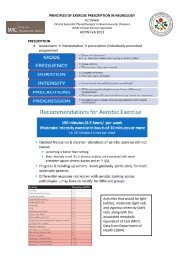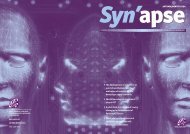Vestibular rehabilitation - acpin
Vestibular rehabilitation - acpin
Vestibular rehabilitation - acpin
Create successful ePaper yourself
Turn your PDF publications into a flip-book with our unique Google optimized e-Paper software.
Anne Rodger <br />
ACPIN Conference and AGM <br />
10/03/2012
Ves$bular Rehabilita$on <br />
5 -‐10% normal population experience vertigo at some <br />
point – incidence increases with age <br />
BPPV lifetime prevalence of 2.4% (Bhattacharyya et al <br />
2008)
Dynamic systems framework <br />
postural control (PC) <br />
Integration <br />
<br />
<br />
<br />
<br />
Task – What postural <br />
demand <br />
Environment: <br />
Individual: <br />
Cognitive: including <br />
internal models of body, <br />
attention, confidence etc <br />
Sensory: Integration, to <br />
determine position and <br />
motion of body in space: <br />
vision, proprioception and <br />
vestibular systems) <br />
Motor commands to <br />
control the body in space <br />
<br />
Shumway-‐Cook and Woollacott <br />
2007) <br />
Strategies to adapt to varying <br />
task and environmental <br />
demands. <br />
Individual<br />
Motor<br />
Sensory<br />
cognition<br />
Task<br />
PC <br />
Environment
Balance emerges … <br />
processing <br />
(sensory and musculoskeletal <br />
systems) <br />
Input <br />
output
Ves$bular system <br />
Website for this image<br />
4086-004-EA855487.gif<br />
• subject to copyright.<br />
Type: <br />
GIF
When it goes wrong
? <br />
How much of a problem is vestibular dysfunction in an <br />
elderly population? <br />
How much of a problem is it in MS? Is this a central of <br />
peripheral issue? <br />
How much of an problem is it in TBI or posterior fossa <br />
tumours? <br />
Do YOU always assess vestibular function in these groups?
Elderly -‐ Un-‐Diagnosed and Under <br />
treated? <br />
Dizziness is very common (Lawson et al 2008) <br />
1/3 people over the age of 65 fall annually -‐ rises with age. (Liston et al <br />
2011) <br />
<strong>Vestibular</strong> function declines with age. <br />
50% of people in their 60s are unable to maintain balance when only <br />
vestibular cues are present (rises with age ~70% for over 70s and 85% <br />
for over 80s (Liston et al 2011) <br />
Most elderly fallers attend Geriatricians / falls service not ENT <br />
73% older adults referred for falls assessment had vestibular <br />
impairment (Liston et al 2011) <br />
50% all dizziness in older people is due to BPPV (Oghalai et al 2000)
MS – A central or peripheral <br />
problem? <br />
50% pwMS report vertigo at some point (Karatas 2008) <br />
Most common cause of vertigo in pwMS -‐ 52%= BPPV with <br />
32% brainstem (Frohman et al 2000) <br />
BPPV = the cause in 60% (in Frohman 2003) <br />
83% pwRRMS tested had vestibular pathology of peripheral <br />
aetiology, ONLY 3% had central symptoms (Zeigelboim et al <br />
2008). <br />
In MS customised VR shown to improve fatigue, balance <br />
function and perceived disability compared to control groups <br />
receiving strength or endurance training (Herbert et al 2011)
TBI & posterior fossa tumours <br />
BPPV is most common cause of dizziness post TBI -‐ <br />
only 8% are Central (Luxon and Davies 1995). <br />
Central / Peripheral – need an accurate diagnosis. Dix <br />
Hall-‐Pike, eye movements <br />
Commonly undiagnosed? <br />
Posterior fossa tumours – vertigo and reduced balance <br />
common.
What is Ves$bular Rehabilita$on <br />
(VR)? <br />
Canalith repositioning <br />
Exercises <br />
adaptation exercises for gaze stabilization <br />
habituation exercises <br />
substitution training for visual or somatosensory input <br />
postural control exercises <br />
fall prevention training <br />
patient and family education. <br />
VR effective but variable results -‐ 60%–85% improvement <br />
(Cass et al 1996, Topuz et al 2004)
Subjec$ve Assessment -‐ <br />
Onset – gradual, recent, longstanding <br />
Duration <br />
How they describe symptoms <br />
Frequency/irritability, severity <br />
Precipitating factors <br />
Functional context <br />
Level of control over symptoms <br />
Psychological state
Objec$ve assessment <br />
Visual: <br />
Observation at rest; smooth pursuit, saccades, VOR and <br />
VOR with head thrusts, VOR suppression <br />
Physical: <br />
Balance <br />
Posture <br />
Sensation/Proprioception <br />
Movement patterns, posture, muscle strength, range of <br />
movement-‐particularly of neck, how they interact, gait <br />
Symptom provoking movements – bending, turning etc <br />
Visual provoking movements
Other Causes of Dizziness <br />
VBI <br />
Postural Hypotension <br />
Hyperventilation and <br />
Anxiety <br />
Thyroid <br />
Medications <br />
Anaemia <br />
Cardiac problems -‐ <br />
arrhthmias etc <br />
Vasovagal Attacks <br />
Hypoglycaemia <br />
Psychiatric <br />
Therefore a detailed <br />
history needs to be <br />
taken.
Outcome measures <br />
Subjective: <br />
Dizziness Handicap Index (DHI) <br />
<strong>Vestibular</strong> Disorders of Daily Living Scale (VADL) (Cohen 2000) <br />
Vertigo Symptom Scale VSS (Yardley et al 1992) <br />
VAS (Visual Analogue Scales) <br />
Functional: <br />
Timed Get Up and Go <br />
Berg Balance <br />
Timed Ten Metre Walk <br />
Dynamic Gait Index <br />
VOR <br />
Dynamic Visual Acuity (DVA) <br />
Sensory Integration <br />
(mCTSIB) (Modified Clinical Test of Sensory Integration of Balance (Wrisley et <br />
al 2004, Whitney et al 2004)) <br />
Motion Sensitivity / Movement Triggers <br />
MST (Motion Sensitivity Test (Akin and Davenport 2003)
Physiotherapy Treatment <br />
Aim to <br />
Reduce dizziness <br />
Improve gaze stability <br />
Improve postural stability <br />
Improve functional abilities <br />
By encouraging compensation, whereby symptoms <br />
progressively lessen, by a variety of mechanisms <br />
Spontaneous <br />
Adaptation (neural plasticity) – enhancing VOR and VSR so less input is <br />
required <br />
Substitution, prediction and other cognitive strategies (Herdman 1994). <br />
Compensation through Habituation
Mechanisms of recovery <br />
Spontaneous <br />
Occurs by a lessening of the static dysfunction <br />
Corresponds with recovery of firing rate of the <br />
vestibular nucleus <br />
Often occurs in first few days -‐ weeks <br />
Enhanced by movement and delayed by inactivity <br />
Partial or full recovery
Mechanism of recovery: Adapta$on/<br />
plas$city <br />
Ability of the V.S. to make long term changes in the <br />
neuronal response to an input <br />
Adaptation is induced by retinal slip (movement of image <br />
across retina) <br />
Retinal slip sends an error signal, which brain tries to <br />
minimise -‐ by increasing the gain on the vestibular <br />
responses (Girardi & Konrad 1998) = Re-‐Calibration <br />
Repetition increases the adaptation (Girardi & Konrad 1998) <br />
Context specific to: <br />
frequency of head movement <br />
directional plane of movement <br />
target distance
Adapta$on exercises <br />
Aim to increase the gain of the VOR. (Girardi & Konrad 1998) <br />
Increase the tolerance to head movement. <br />
head movement, eyes focus on object (= x1) <br />
Head and object move, whilst focussing on object (= x2) <br />
Change distance, speed, direction, background, postural demands. <br />
Should train for 1 -‐2 minutes <br />
Repeat 3-‐5 times a day <br />
Context specific <br />
Herdman 2002) <br />
Virre & Sitarz 2002 found good results for 2 x 30 minutes <br />
sessions for a week subjects looking at moving images on a <br />
computer
Mechanisms of recovery Subs$tu$on. <br />
Primarily for bilateral disorders <br />
Other strategies replace the lost vestibular <br />
function (visual and somatosensory) <br />
A number of reflexes can be optimised <br />
COR which operates at low frequency (under 0.1) can partially <br />
compensate by increasing its range-‐ up to 0.3Hz (Herdman 1997) <br />
VCR (vestibulo-‐collic reflex) aligns head to gravitational vertical <br />
and the CCR (cervico-‐collic reflex) aligns head to the body, can <br />
increase their influence in posturally challenging circumstances or <br />
in balance problems (Guitton et al 1986)
Subs$tu$on Con$nued <br />
Performance of saccadic eye movements to help <br />
regain the target <br />
Use of visual and somatosensory cues <br />
Advice on safety at night, swimming etc <br />
Strategies based on prediction or anticipation (Zee <br />
2000) <br />
Strategies ineffective for <br />
fast, unexpected movements <br />
or when the cues are inaccurate / not available
Mechanisms of recovery <br />
Habitua$on <br />
A reduction of a ‘pathological’ response to a <br />
stimulus brought about by repeated exposure to <br />
that stimulus (movement or posture) <br />
Desensitisation -‐ eventually the stimulus has to be <br />
stronger in order to be symptomatic (Girardi & Konrad <br />
1998) <br />
Repetition – vital for LTP (Shumway-‐Cook and Woolacott <br />
2001)
Habitua$on exercises <br />
Tailoring vertigo producing manoeuvres within an <br />
ADL setting, or getting patient to repeat postures <br />
or symptom producing activities. <br />
Cawthorne-‐Cooksey Exercises (CCE) <br />
Brandt Daroff <br />
?outdated or poorly evaluated
Visual Ver$go <br />
Symptoms provoked or aggravated by specific visual <br />
contexts, (supermarkets, driving or movement of <br />
objects) (Guerraz et al 2001) <br />
Patients have an abnormally large perceptual and <br />
postural responses to disorientating visual <br />
environments <br />
Treatment needs to involve visual motion <br />
desensitisation – e.g. repeated optokinetic stimulation <br />
High tech: Planetarium or low tech: DVD (Pavlou 2006, <br />
2010)
Summary <br />
<strong>Vestibular</strong> dysfunction is common. <br />
In neurological patients the vestibular dysfunction is not <br />
necessarily from Central origin. <br />
Physiotherapists have an important role; success comes <br />
from: hard sell based on an accurate comprehensive <br />
assessment and tailored treatment plan <br />
-‐ If in doubt: Encourage movement and visual movement
Ques$ons? <br />
anne.rodger@uclh.nhs.uk
References <br />
Bhattacharyya, N; Baugh, R; Orvidas, L; et al (2008). Clinical <br />
practice guideline: Benign paroxysmal positional vertigo. <br />
Otolaryngology–Head and Neck Surgery 139, S47-‐S81 <br />
Cass, S. Borello-‐France, D. Furman, J. 1996. ‘Functional <br />
outcome of vestibular <strong>rehabilitation</strong> in patients with abnormal <br />
sensory-‐organisation testing’ American Journal of Otology 17: <br />
581-‐ 94 <br />
Frohman E, Zhang H, Dewey R, Hawker K, Racke M, Frohman T <br />
(2000). Vertigo in MS: utility of positional and particle <br />
repositioning manoeuvres. Neurology, 55(10), 1566-‐9. <br />
Frohman E; Kramer P; Dewey R; Kramer L; Frohman T. (2003). <br />
Benign paroxysmal positioning vertigo in multiple sclerosis: <br />
diagnosis, pathophysiology and therapeutic techniques Multiple <br />
Sclerosis, 1 June, vol. 9, no. 3, pp. 250-‐255(6)
References 2 <br />
Girardi, M. Konrad, H (1998). ‘<strong>Vestibular</strong> <strong>rehabilitation</strong> <br />
therapy for the patient with dizziness and balance disorders’. <br />
Orl-‐Head and Neck Nursing. Fall Volume 16, no. 4 13-‐ 22. <br />
Guerraz, M. et al (2001) ‘Visual vertigo: symptom assessment, <br />
spatial orientation and postural control’ Brain 124 (8): 1646-‐1656 <br />
Guitton, D. Kearney, R. Wereley, N. Peterson, B. (1986). <br />
‘Visual, vestibular and voluntary contributions to human head <br />
stabilisation’ Experimental Brain Research. 64: 59-‐69 <br />
Hebert, J: Corboy,J; Manago, M: Schenkman, M. (2011) Effects of <br />
vestibular <strong>rehabilitation</strong> on multiple sclerosis-‐related fatigue <br />
and upright postural control: a randomized controlled trial. <br />
Phys Ther. Aug;91(8):1166-‐83 <br />
Herdman, S (1994). <strong>Vestibular</strong> Rehabilitation’. F.A. Davis Co. <br />
Phildelphia <br />
Herdman, S. (1997). ‘Advances in the treatment of vestibular <br />
disorders’. Physical Therapy 77: 602-‐618 <br />
Herdman, S & Whitney S. 2007 Interventions for the patient <br />
with vestibular hypofunction, chapter 20 in <strong>Vestibular</strong> <br />
Rehabilitation. Susan Herdman Third Edition FA Davies <br />
Company Philadelphia.
References 3 <br />
Karatas, M (2008). Central vertigo and dizziness: epidemiology, <br />
differential diagnosis and common causes. The Neuologist, 14 (6):<br />
355-‐364) <br />
Lawson, J. Bamiou, D. Cohen, H. & Newton, J. (2008) Positional <br />
vertigo in a falls service Age Ageing 37 (5): 585-‐588. <br />
Liston, M; Bamiou, D; Martin, F;Luxon, L; Pavlou, M. (2011) <strong>Vestibular</strong> <br />
function in unexplained falls. Abstract for British Society of Neuro-otology.<br />
<br />
Luxon, L & Davies, R. 1995. ‘Handbook of <strong>Vestibular</strong> Rehabilitation. <br />
Oghalai, J. S., et al. (2000). "Unrecognized benign paroxysmal <br />
positional vertigo in elderly patients." Otolaryngol Head Neck Surg <br />
122(5): 630-‐4 <br />
Pavlou, M. (2010) The Use of Optokinetic Stimulation in <strong>Vestibular</strong> <br />
Rehabilitation. Journal of Neurologic Physical Therapy: Volume 34 -‐ <br />
Issue 2 -‐ pp 105-‐110
References 4 <br />
Pavlou, M. Davies, R. Bronstein, A. (2006). The assessment of <br />
increased sensitivity to visual stimuli in patients with chronic <br />
Dizziness. Journal of <strong>Vestibular</strong> Research 16 223–231 <br />
Shumway-‐Cook A, Woollacott M (2007) Motor Control Theory and <br />
Practical Applications Third Ed Lippincott Williams and Wilkins <br />
Philadelphia. <br />
Topuz O, Ardic F, Sarhus M, Ogman G, (2004) Efficacy of vestibular <br />
<strong>rehabilitation</strong> on chronic unilateral vestibular dysfunction Clinical <br />
Rehabilitation18(1):76-‐83. <br />
Zee, D 2000 ‘<strong>Vestibular</strong> Adaptation’ in <strong>Vestibular</strong> Rehabilitation Susan <br />
Herdman (2 nd Ed) Contemporary Perspectives in Rehabilitation. F A <br />
Davis Company. Philidelphia <br />
Zeigelboim, B; Arruda, W; Mangabeira-‐Albernaz, P. et al. (2008). <br />
<strong>Vestibular</strong> Findings in Relapsing, Remitting Multiple Sclerosis: A <br />
Study of Thirty Patients International Tinnitus Journal, Vol. 14, No. 2, <br />
139–145




